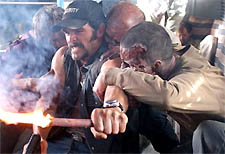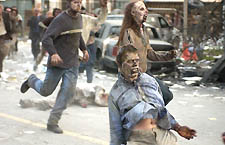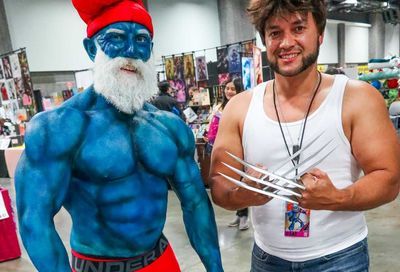Resurrection
''Dawn of the Dead''
 |
It’s been almost two decades since I last watched George Romero’s 1978 cult classic Dawn of the Dead, a pinnacle achievement for both the hit-and-miss horrormeister and for the zombie-film genre overall. I remember less about plot specifics than I do certain gore-drenched set pieces, such as the alarming sight of a mother being attacked by her undead son (he takes a big bite out of her shoulder), a zombie getting the top of his head lopped off by a helicopter blade and a man being ripped open alive and disemboweled by human offal-craving undead. These moments made quite an impression on me — and they considerably upped the shock value found in Romero’s Night of the Living Dead, made a decade earlier in 1968 and which remains to this day one of cinema’s creepiest, most unsettling experiences.
In 1978, however, moviegoers were still not accustomed to excessive gore. Twenty-five years later, the spillage of blood and guts is so routine, it’s even made it in a significant way onto television’s airwaves. It takes a hell of a lot to gross us out, not to mention scare the bejeezus out of us.
 |
Perhaps it is wise, then, that first-time director Zack Snyder, in resurrecting Dawn of the Dead, has fashioned an experience that is overall less viscerally shocking than the original. He’s not trying to outdo what Romero did so very brilliantly. This is no unrated gore-o-rama (though it has its moments). Nor is it much of a social commentary as Snyder has excised the satirical undertones of consumerism that permeated the original Dawn (though they still lurk beneath the surface in that the film’s principal action still takes place in a shopping mall).
 |
Recent works like 28 Days Later and Cabin Fever have re-imagined the usual zombie-film conventions, yet neither are as effective or impactful as Snyder’s Dawn, which remains narratively streamlined in its tale of a few survivors who must avoid becoming zombie chow and, with any luck, escape a city in apocalyptic ruins. Snyder and screenwriter James Gunn (who based his work on Romero’s original) aren’t interested in socio-political underpinnings or subtext — though God knows, you can read anything you want into lines like “When there’s no room left in Hell, the dead will walk the Earth ” — but rather want to keep us perpetually on edge and creeped out. When called upon to up the fear factor, Snyder aims for pure, unadulterated intensity and more often than not hits a bullseye.
The new Dawn of the Dead achieves a good balance of impending dread and doom and action-pumped sequences. The opening ten minutes in particular are a stunning exercise in frantic, unexplained turmoil, and the climactic twenty, as the remaining survivors attempt to escape the mall and plow through legions of living dead folk with the help of a couple of heavily reinforced trams, is breathtaking in its intensity and in its extreme gore payoff.
 |
Unlike Romero’s version, in which the undead lumbered slowly yet purposefully, Snyder’s zombies are ferocious, frenzied creatures. It seems as though the minute a person reawakens from what should have been eternal slumber, he or she becomes a world-class sprinter. (Hey, here’s a sequel idea for you — Olympics of the Living Dead.) The fly in the embalming fluid is that unlike Romero’s conceit, in which anyone dead was reanimated and then went off in search of living humans on which to feed, these zombies are created only by infection. Basically, you get bitten, you die, you spring back to life. Not to nitpick, but the trouble with the scenario is that there are so many dead in Snyder’s film — seemingly endless hordes — that the rapid rate of infection makes no sense. The dead are supposed to be feeding voraciously on the living — not just biting them and adding to their numbers. Where’s the terror in that?
|
Snyder worked with a decent budget of $26 million and he puts it to good use. (Romero, by contrast, worked with a small fraction of that amount.) The acting is solid — particularly noteworthy are Sarah Polley as a resourceful, strong-willed nurse, Ving Rhames and Jake Weber as the resident male heroes, Ty Burrell as the somewhat sleazy cravenly coward and Mekhi Phifer as a man desperate to save the life of his infected pregnant wife and the unborn (and possibly undead) child.
Still, Dawn of the Dead leaves us feeling mildly ambivalent toward the genre, a knee-jerk result of having seen too many over-the-top zombie films in the ensuing quarter century since the release of the original — including Lord of the Rings maestro Peter Jackson’s gore-splendent zombiefest Dead Alive (which featured, among other things, a marauding intestinal tract), and Dan O’Bannon’s deliriously entertaining satire Return of the Living Dead.
So unless someone can come up with something new for the inevitable sequel to Dawn, perhaps it’s time the dead remained good and buried.
Support Metro Weekly’s Journalism
These are challenging times for news organizations. And yet it’s crucial we stay active and provide vital resources and information to both our local readers and the world. So won’t you please take a moment and consider supporting Metro Weekly with a membership? For as little as $5 a month, you can help ensure Metro Weekly magazine and MetroWeekly.com remain free, viable resources as we provide the best, most diverse, culturally-resonant LGBTQ coverage in both the D.C. region and around the world. Memberships come with exclusive perks and discounts, your own personal digital delivery of each week’s magazine (and an archive), access to our Member's Lounge when it launches this fall, and exclusive members-only items like Metro Weekly Membership Mugs and Tote Bags! Check out all our membership levels here and please join us today!




















